In this room is exhibited a large sample of the works made with skins and plant fibers by the pre-Hispanic population of Gran Canaria.
With regard to the manufacture of plant fibres, the use of two species, the reed and the Canarian palm tree, has been identified, with a clear predominance of the first. The processing applied to the reed consisted of a desiccating, after which the crushing took place for the production of fibers, although in some examples you can observe the use of the stem only desiccated, preserving its original cylindrical structure. These differences in preparation are likely to be in relation to the type of object to be made (recipients, mats, clothing, ropes, etc.) and the role it was to play. In the case of the palm tree, the leaflets would be exploited, after which the fibres would be obtained.
Various products made of leather (possible clothing, containers, etc.) are shown in the room. Like plant fibers, the skin was worked in different ways, so that rough tanning is observed against other very elaborate ones, or leathers that preserve the hair compared to other hairs. A variety that would be based on the purposes for which these manufactures were intended but also on the social status of the individuals to which the objects were addressed.
In general, the pieces made with leather denote the perfection achieved in this type of manufactures, as can be seen by observing the thoroughness of its seams – made with strips of leather and tendons – or decoration by means of incisions or application of almagre for the drawing of geometric figures.
The manufacture of skin and plant fibers denotes a standardization and therefore a gestural repetition – which can be detected, for example, in the seams and “patches” or in the types of fabric – which, together with other archaeological testimonies, leads to the observation that these works were developed by a specific segment of the population.

